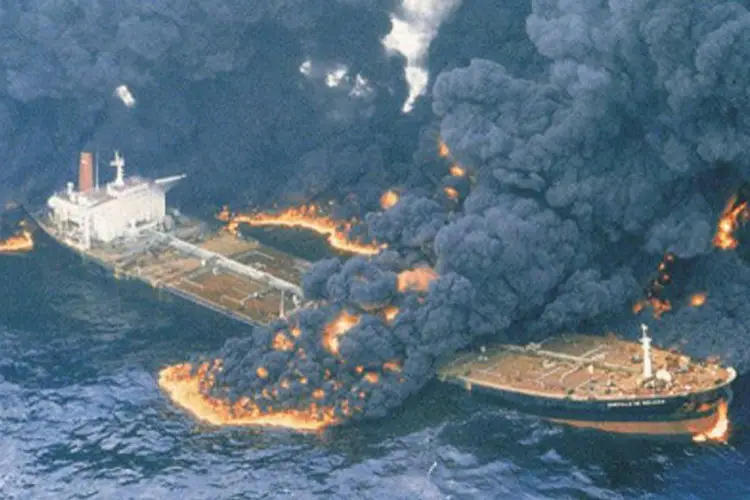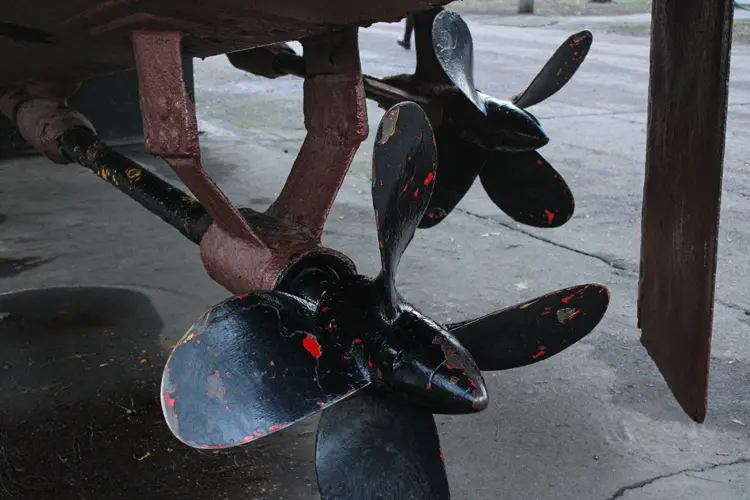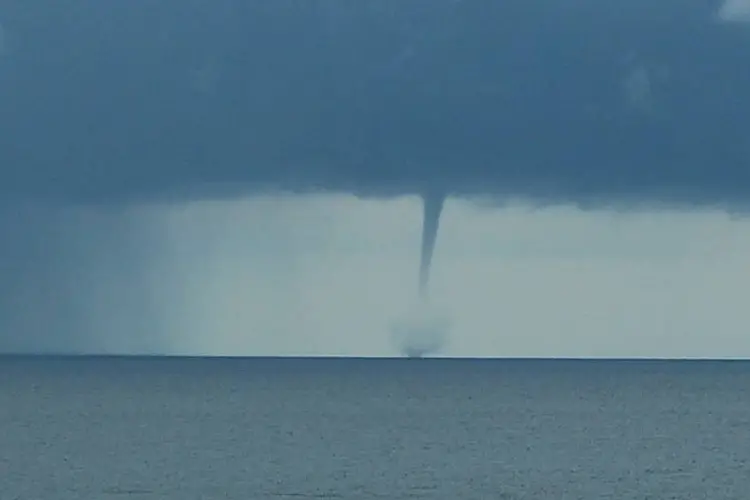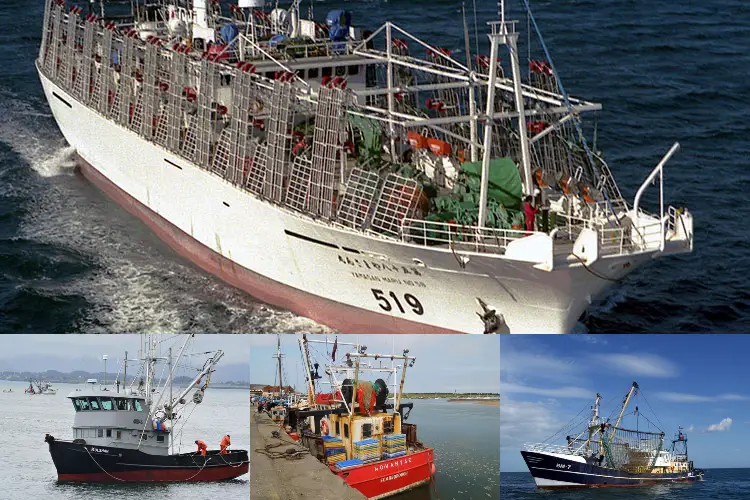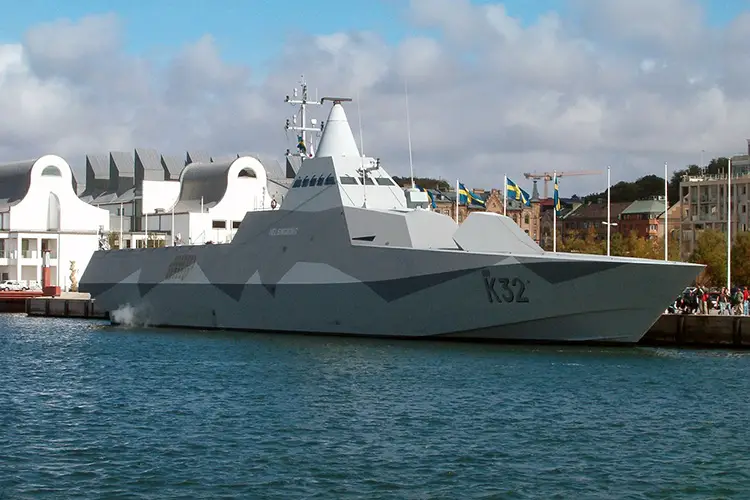Oil Spills And Their Impact

What is an Oil Spill?
The accidental disposal of oil into the water of oceans and seas due to careless handling or human error is called an oil spill. Oil spills cause widespread destruction of the aquatic ecosystem as well as huge economic loss. The indispensability of oil in our day-to-day lives is unquestionable. The number of industries that are heavily reliant on oil as its source of fuel is vast. But what comes as a blessing, if not appropriately handled this blessing can turn into a bane.
Over the years with its increased usage it has become a threat to the environment. This is especially due to the improper and careless handling of oil over waterways and accidental spillage. It causes severe distress to the marine life of the region and its nearby areas. It is important to know that every ecosystem is interconnected. So, when one is disturbed, consequentially the balance in the other ecosystems is disturbed too.
Reports say that an estimated 706 million gallons of waste oil get released into the oceans yearly. The majority of this waste oil comes from land drainage and waste disposal: e.g., the deposition of motor oil that has not been treated properly.
Contribution of Drilling and Transportation
There are various stages involved in drilling, and an accidental oil spill can occur at any of these stages. Leaks may happen while production, while handling, transporting and even while storing the oil. 2.1% of the 706 million gallons of waste oil are from drilling operations. Another 5.2 comes from the transportation processes. So, we see that the amount of oil spilled during the operations is not that much it adds up, nonetheless.
The question may arise that how exactly the offshore drilling operations cause oil spillage. These are generally caused by wastes from oil-based drilling mud, leakage of pipelines and flowlines, deck runoff water, or from well failures or blowouts. While transportation the tankers and ships can end up spilling their fuel or the oil they are carrying as cargo. These oils are of several types, including crude oil, fuel oil, heating oil, etc.
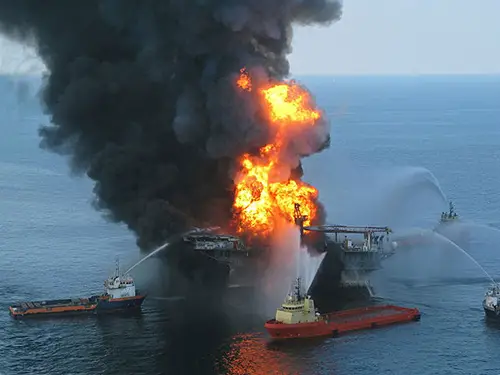
What happens when oil is spilled?
Initially, when oil comes in contact with the water, it spreads mostly over the surface. The layer of oil thus formed may remain cohesive or break up depending on how the rough the sea is. Due to the wind and current, this layer spreads to a larger area – in the open oceans, coastal regions depending on the direction of the flow of wind or current. It spreads even further into marine and terrestrial habitats.
Volatile oil loses somewhere between 20% to 40% of its mass due to evaporation. It leads to an increase in its viscosity and thickness. A small percentage of oil gets dissolved in water.
A frothy brown emulsion may also be formed on the surface of the water and get dispersed with it. Portions of the oil may sink along with some particulate matter while another portion of it may result in the formation of sticky tarballs. Over time, oil waste wears out and disintegrates by mainly two methods, photolysis and biodegradation.
Read more: What Are The Causes And Effects Of Ocean Pollution?
Photolysis is the chemical reaction where a chemical compound gets broken down by photons or simply put by light. Biodegradation is the disintegration of materials by bacteria, fungi, or other biological means.
Since the latter process is carried out by microorganisms, it is dependent on the availability of nutrients, oxygen, and microorganisms, as well as temperature.
The oil that spreads to the shore due to water current, waves or wind causes contamination and erosion of the beach through its gravel, rocks, and boulders. It negatively impacts the lives of both humans and animals living in the vicinity.
The sticky residue that coats the rocks and boulders are toxic to coastal wildlife and also hampers the recreational activities that are usually carried out on the shores. The coating also hinders its ability to provide nourishment to the vegetation.
Oil spills are fatal for the marine ecosystem. Fish and other aquatic creatures die due to the toxicity. This creates a chain reaction. The ecosystems of this planet are all inter-dependent. So, when one suffers, the effect can be felt in all the other ecosystems as well. The toxicity is not limited to flora and fauna present in the water only.
Some birds catch their food from the water. They no longer have access to that food. What is worse is the fact that when they come into contact with the water of the contaminated area, they get contaminated. The entire food chain is affected as a result.
There are people whose livelihood is reliant on fishing. When the fish die, there is nothing left for them to fish. It leads to a spike in the unemployment rate of the area and also the companies dealing with commercial fishing suffer.
Now let us take a look at the exact process of how the organisms are harmed. The oil spills poison not just the fish, but also sea creatures, including mammals, reptiles, amphibians, and birds that live in or near the ocean. When these creatures ingest the oil their digestive system and even their respiratory and reproductive systems get affected. Thus, their behavioral pattern changes. The oil also causes them to suffocate. The disruption caused in the ecosystems is almost irreversible.
Coastal regions are vital not just because of the fishing industries but also because of the recreational activities, like boating, snorkeling and scuba diving, swimming, etc.
Apart from these activities’ tourists are also attracted to nature parks and preserves, beaches, etc. These form some of the significant industries near the coast. All of these get hampered when such accidents happen. So many people that were recruited by these companies lose their job.
Investors refrain from investing money in these areas. Thus, the economy of this region takes a hit. Consequentially the overall value of this area deteriorates drastically.
What happens to the oil in the long run?
What happens to the oil, in the long run, is dependent on a large number of factors, e.g., the properties of the oil, its composition, how much oil is available on the shore, the type of beach, etc. It also depends on what kind of sediments and rocks the oil comes in contact with. Different types of oil respond to the variations in seasonal and climatic conditions of a place in a different way.
Some oil creates a more significant impact on the habitats of aquatic and marine animals while others not as much. The process of evaporation, emulsification, and decomposition is also equally arbitrary.
Some types of oil form a tar-like substance that is extra difficult to remove and generally removal and cleaning the area contaminated by such oil can prove to be more harmful than useful.
Clean-up Process and Recovery
Most of the time the oil goes through a weathering process. But it takes time. To facilitate the process, several methods are used. They include natural and assisted biodegradation, containment and removal, and dispersion.
The last process can be achieved through skimming, filtering, or combustion. Which of these techniques would be the most appropriate to use depends on the characteristics of the environment?
The procedure used when the oil spill has occurred in an open ocean will differ from that in coastal regions and wetlands.
Wildlife species that are bigger are transported to a separate facility while the clean-up process is being carried out and when the process is complicated, they are returned to their natural habitats. The same procedure cannot be followed in the case of smaller species.
The process of choosing the correct countermeasure for oil spills is not that easy because some things need to be kept in mind.
Care must be taken that the clean-up process and contingency plans do not create a negative impact on the socio-economy of the region. It should be made sure that while trying to remove the toxin from one place another place is not harmed.
Proper care should be taken while handling the equipment used in the process to be executed.
Read more: 15 Common Oil Cleanup Methods At Sea
Success Rate
There is no guarantee as to how far the recovery process will be successful. Much of the success is dependent on the nature and composition of the spilled oil, the characteristics of the area that has been affected.
Large-scale recovery of the environment through decontamination and physical removal of oil waste can prove to be harmful to the substrate biomass. If the process decided upon is bioremediation then the addition of microorganisms, nutrients, and oxygen can speed up the process.
Some of the biggest oil spills in history
The world has seen a significant number of oil spills, some of which were nothing short of terribly disastrous for the ecology of the ocean.
The Kolva Rover Oil Spill of 1994 in the Russian Arctic ocean which was caused by a breach in a corroded pipeline is one of the most infamous oil spills. It led to a spill of nearly 84 million gallons of oil over an area of more than 180 sq. Km in the Kolva River. The cleaning process for this disaster was not an easy one.
Also read: 13 Major Oil Spills Of The Maritime World
BP Deepwater Horizon Oil Spill of 2010 is also in the list of some of the largest oil spills in history. It happened in the Gulf of Mexico on 20 April 2010 when a surge of natural gas blasted through a recently installed cement wall cap. This disaster led to the deaths of 11 workers, and nearly 17 were injured. About 134 million gallons of oil were spilled over an area of 2100 km. The cleanup and the compensation charges that the company had to pay were as high as 65 billion dollars.
Gulf War of 1991 in Kuwait marks one of the most massive oil spills in history where around 240 million to 336 million gallons of oil were spilled into the ocean out of which only about 59 million gallons could be recovered. This oil spill took place as a result of the Iraqi forces opening the oil valves of Kuwait. This is considered as the biggest oil spill in history.
Another major oil spill was the oil spill off the Atlantic Empress in Trinidad and Tobago in the year 1979. Nearly 88 million gallons of oil were spilled, and the disaster also led to the deaths of as many as 26 crew members.
Some more examples of significant oil spills are the Fergana Valley oil spill of 1992 in Uzbekistan, the Odyssey oil spill of 1988 off the coast of Nova Scotia, Canada, the Exxon Valdez oil spill of 1989, etc.
Conclusion
An oil spill is a costly affair in more than one way. First of all, oil is wasted. But that is not the end of it because the company now needs to pay for the clean-up of the oil and these sums are no meager amount.
Several penalties also need to be paid if such an accident occurs. But that is always recoverable if the business continues to grow. However, in addition to this, there is a considerable cost associated with the loss of marine life and other ecosystems that are in close contact with it. Exposure to contaminated soil and water is detrimental to human health. Human beings are affected not only in terms of health, but their livelihoods are also at stake.
Nowadays with specific strict rules and regulations regarding the prevention of oil spills taking certain measures has become mandatory. The Oil Pollution Act of 1990 was enacted by the U.S. Congress to strengthen oil spill prevention, planning, response, and restoration efforts. The Oil Spill Liability Trust Fund provides the clean-up funds for oil pollution incidents under the provision of the act.
The only way to prevent oil spills is by being a little bit more careful and responsible. No one party can be blamed entirely for such an accident, be it the government, the industry or an individual, and thus it becomes the responsibility of everyone to make sure such mishaps do not happen in the future.

